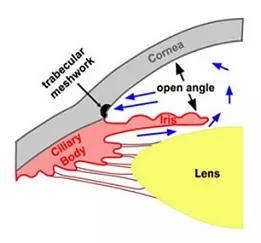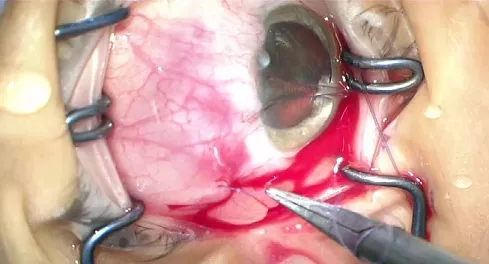Why is bleb needling (and bleb revision) necessary?
Bleb needling (and bleb revision) is performed for patients whose eye pressure has increased due to scar tissue following initial trabeculectomy surgery.

Fluid in the eye (aqueous) is produced by the ciliary body, and drains out through the trabecular meshwork (drainage pathway) in the drainage angle. Sometimes the trabecular meshwork no longer copes, preventing aqueous from draining out easily. This causes pressure to build up in the eyeball. When the pressure in the eye is too high, it can cause optic nerve damage and permanent vision loss – this is called glaucoma.
During a trabeculectomy procedure, a channel with a trap door on the wall of the eye (sclera) is formed – this allows aqueous to drain out of the eyeball into a pocket of fluid called a ‘bleb’. Bleb failure can occur due to scarring of the trap door and bleb, which prevents aqueous from draining out of the eye, thus increasing the eye pressure.
The bleb needling (and bleb revision) procedure cuts the scar tissue and frees the trap door and bleb, thus re-establishing aqueous flow into the bleb. Doing so decreases the eye pressure, which in turn reduces the risk of further optic nerve damage from glaucoma.
See Related: Surgical treatments for glaucoma
What does bleb needling involve?
Bleb needling is a surgical procedure which involves:● Using a needle or blade to cut the scar tissue at the trap door and bleb
● Applying or injecting an anti-scarring medication (mitomycin-C or
5-fluorouracil) to try to prevent the trap door and bleb from scarring again.
● Sometimes a more invasive procedure is required, which requires
entering the eyeball with the needle or blade, and/or re-stitching of the
trap door and bleb. This form of needling is called a bleb revision and is
usually performed in an operating theatre.

What are the potential risks of bleb needling?
Bleb needling is generally safe. Most complications can be treated although sight-threatening complications may occur rarely (less than 1 in every 1000). Risks include:
● Bleeding into the eye. This usually settles gradually over a few weeks.
● Low pressure in the eye (hypotony). This usually settles over the course
of several weeks to months. Rarely, it can be severe and cause reduced
vision in the long term.
● High pressure in the eye. The pressure can be reduced by releasing
aqueous from the eye or by massaging the eye. However, if the pressure
remains persistently high, you may require pressure-lowering eye drops
or tablets.
● Infection inside the eye (endophthalmitis). This is the most serious
complication and may cause permanent sight loss despite treatment with
antibiotics and surgery.
See Related: Risks and complications of glaucoma surgery
What should I expect with bleb needling?
Bleb needling is an office-based procedure, and does not require sedation or admission to the hospital.
Before bleb needling:
On the day of your procedure, please take all your usual medications unless otherwise advised. You will not be able to drive home on the day of the procedure, so you will need to arrange for someone to take you home. Please allow at least 2 hours.
Before the injection, local anaesthetic eye drops will be instilled to numb the eye. You may also receive eye drops to dilate the pupil.
During bleb needling:
Bleb needling is performed with a very small needle at the slit lamp. To reduce the risk of infection, povidone iodine antiseptic may be used to clean your eye and eyelashes. You will be asked to keep your eyes still looking downwards.
The procedure takes around 5 minutes to perform. It shouldn’t be painful although you may feel a sting towards the end of the procedure. At the end of bleb needling, your eye will be flushed with normal saline.
After bleb needling:
Your eye may feel a bit sore after the anesthetic wears off. Over the next few days, you may experience some blurriness, irritation, blood around the eye, and increased watering. These will gradually improve without any treatment.
You will need to use steroid anti-inflammatory eye drops (Prednisolone or Dexamethasone) 4 to 6 times daily. These drops will be decreased gradually over several months.
You will usually be reviewed 1 to 2 weeks after bleb needling. At your follow-up visits, bleb needling and injections of anti-scarring medication (5-fluorouracil) may need to be repeated.
Please contact the clinic immediately if you experience pain or a sharp drop in vision.
What are the potential risks of bleb revision?
Bleb revision is generally safe. Most complications can be treated, although sight-threatening complications may occur rarely (less than 1 in every 1000). These can sometimes occur even if the procedure has been carried out perfectly.
If you have severe glaucoma, there is a risk of completely losing all vision due to the stress of the procedure (snuff-out).
Risks during surgery:
● Bleeding into the eye. If severe the operation may be discontinued, and
will need to be completed on another day.
● Damage to other parts of the eye. This will prolong the surgery and your
eye may take a few months to recover instead of a few weeks.

Risks after surgery, where treatment does not involve another procedure:
● Bruising of the eye or eyelids. This is quite common.
● Allergy to the post-surgery eye drops, causing redness and irritation of
the eye and eyelid.
● High pressure in the eye. The pressure can be reduced by releasing
aqueous from the eye, massaging the eye, or by removing or cutting the
trap door stitches. However, if the pressure remains persistently high, you
may require pressure-lowering drops or tablets.
● Low pressure in the eye (hypotony). This usually settles over the course
of several weeks to months. Occasionally, it can be severe and cause
reduced vision in the long term.
Risks after surgery, where treatment requires another surgical procedure:
● Bleb leak. This may cause the eye pressure to become low and increases
the risk of infection. The leak can sometimes heal with the aid of contact
lenses, but usually requires treatment with a bleb revision procedure.
● Bleb failure. Scarring of the trap door and bleb prevents aqueous from
draining out of the eye. During your postoperative visits, you may receive
multiple injections of anti-scarring medication (5-fluorouracil) around the
trap door and bleb to try to prevent the scar tissue from forming again.
● Infection inside the eye (endophthalmitis). This is the most serious
complication and may cause permanent sight loss despite treatment with
antibiotics and surgery.
● Cloudiness of the lens in the eye (cataract). This can be treated with
cataract surgery.
● Droopiness of the eyelid (ptosis). This is usually mild. However if this
causes problems, the eyelid can be lifted by tightening the eyelid muscle
(ptosis surgery).
What should I expect with bleb revision in hospital?
Bleb revision is more invasive than bleb needling, and is safer if performed in hospital. This is a day case procedure performed under local anesthetic. The operation is usually performed one eye at a time.
Before surgery:
On the day of your procedure, please take all your usual medications unless otherwise advised. You will need to fast for at least 6 hours before your procedure. You will not be able to drive home on the day of the procedure, so you will need to arrange for someone to take you home. Please allow at least 3 to 4 hours in the hospital.
Before the trabeculectomy procedure, you will receive the following:
● Eye drops to constrict the pupil. These can take up to 30 minutes to work.
● Cannula inserted into a vein, usually at the back of your hand.
● Local anaesthetic eye drops prior to the anesthetic injection.
● Local anesthetic injection into the eye socket to fully numb the eye.
During surgery:
To reduce the risk of infection, povidone iodine antiseptic is used to clean your eye and eyelashes, a sterile drape will cover your face, and a sterile clip will keep your eyelids open.
You will be awake during surgery, but you should not feel any pain. If you feel discomfort or pain, additional local anaesthetic can be given. It is normal to notice bright lights or colours, hear buzzing and beeping sounds, and feel cold water running down your cheek or ear.
You will need to lie relatively still for up to 45 minutes for the operation. At the end of surgery, you will feel a sting due to an injection.
After surgery:
After bleb revision, a pad and shield will be placed over your eye. The pad and shield can be removed the next day, and you can start your postoperative eye drops. These comprise:
● Steroid anti-inflammatory eye drops (Prednisolone or Dexamethasone)
2-hourly for 4 to 6 weeks. These drops will be decreased gradually over
several months.
● Antibiotic eye drops (Chloramphenicol) 4 times daily for 1 week.
● Steroid eye ointment (Hydrocortisone) at night for 1 month.
You will need to stop your glaucoma eye drops (if any) to the operated eye. However, please continue your usual eye drops to the non-operated eye.
You will be reviewed the next day, and then weekly for a few weeks after bleb revision. During these visits, you may receive injection of an anti-scarring medication (5-fluorouracil) around the bleb. The visits (and injections) will become less frequent as the eye settles.
Please contact the clinic immediately if you experience pain or a sharp drop in vision.
See Related:


